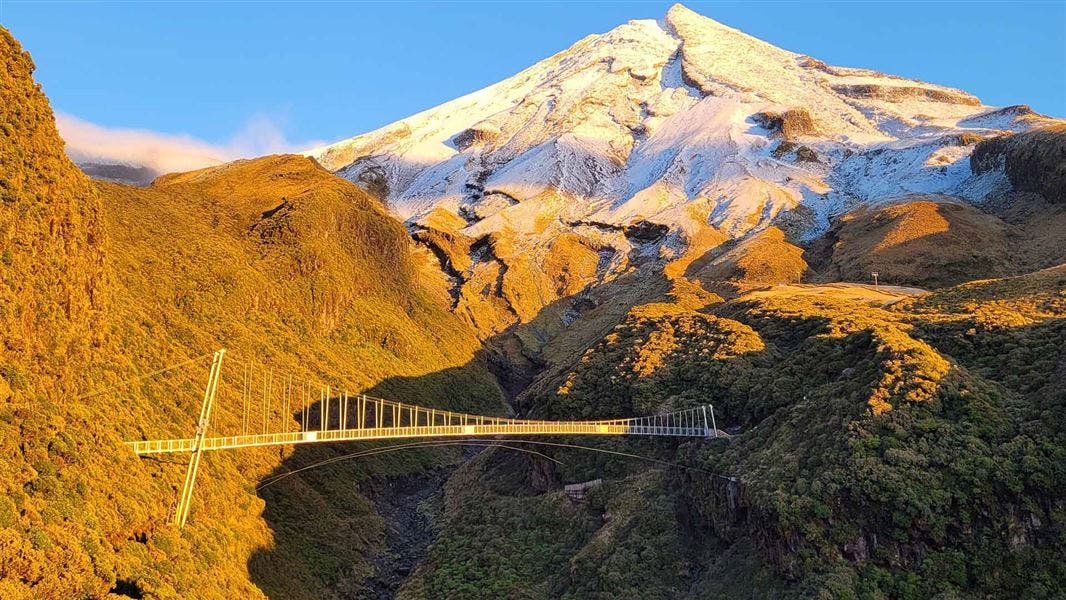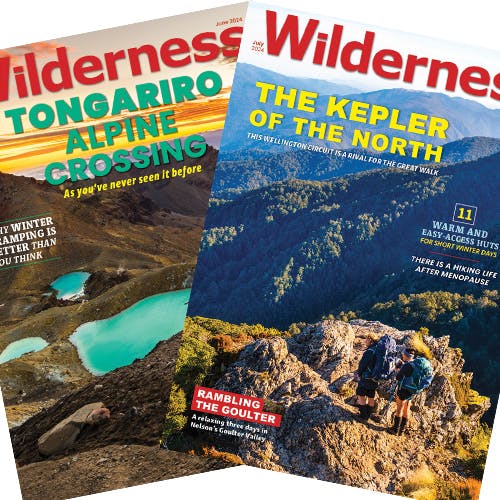A wrap of the biggest stories and best writing about the outdoors from New Zealand and around the world.
Built to last 100 years and withstand a one-in-250-year avalanche, the 100m Manganui Gorge Bridge is a striking piece of infrastructure. DOC has posted a video of the building process and drone footage of the completed bridge.
Dan Crocker, a lead engineer and design architect on the project says, “All the patterning that you see on the balustrade represents all the phases of the avalanche cycle and we’ve got the taonga on the mast that invites people onto the bridge and there’s a touchstone.”
The $1.2 million bridge was a key component of the $13.4 million Taranaki Crossing project being developed in partnership between Ngā Iwi o Taranaki, DOC and Kānoa – the Regional Economic Development & Investment Unit.
Ngāti Ruanui deputy chair Ngapari Nui said the Manganui Gorge Bridge would present opportunities for Ngāti Ruanui, which owned the Stratford Mountain House. “It’s about the tourism kaupapa that we’re hoping for in the future and we do have our tamariki and mokopuna, so our school kids and all of those will get a chance to reconnect with the maunga.” Read the full story from RNZ.
Former Ruapehu Alpine Lifts boss confident he can turn a profit
The former head of a Mt Ruapehu ski field, which went into receivership, disagrees with government officials’ concerns for its future commercial viability and is among those bidding to take on the business.
In March, the Government announced one final bailout for the northern side, Whakapapa Ski Area. A recently released briefing to the Minister for Regional Development Shane Jones, from the Ministry of Business, Innovation and Employment (MBIE) reveals government officials had concerns for Whakapapa’s commercial success when deciding to give it that final loan.
But the former head of RAL, Dave Mazey, now head of a group called Whakapapa Holdings, said he disagreed. Mazey said he was confident in its ability to turn a profit, which it had done “on average every year” since he had started with the company 30 years ago.
The group had said they had submitted an expression of interest in a bid for possession. The final decision would lie with MBIE, as it had taken on the ski field’s debt. Read the full story from the Waikato Herald.
How to airdrop a grizzly bear
The US National Park Service has approved a measure to reintroduce grizzly bears to Washington’s Northern Cascades. The question is how to get them there. Officials are considering a dramatic method of transport: delivering the bears via helicopter.
This method involves hoisting the animals in cargo nets or nylon slings and dangling them hundreds of feet in the air. Pilots would then drop the bears into remote wilderness locations.
While it may seem simple – just scoop up a bear and drop them in a new location – there is actually quite a lot of thought that goes into the relocation. Considerations include genetic testing, the age of the bear and if the relocated bears can get along.
Backpacker has broken down the steps the US National Park Service would need to take if they pursue an ‘operation bear drop.’
14 of Europe’s best long-distance hiking trails
With summer approaching in the northern hemisphere, CNN has curated a list of Europe’s best long-distance hiking trails. The multi-day trails range from the 40km Hyssna Trail in Sweden to the 4,300km King Charles III England Coast Path in (you guessed it) England.
Other notable trails include trekking to the Vikos Gorge in Greece with its 1,350m cliffs, Finland’s most well-known long walk the 82km Karhunkierros Trail, and the epic 11-day Tour du Mont Blanc that travels between France, Italy and Switzerland. See the full list of trails from CNN.
Southern New Zealand dotterels decline by 19 per cent
DOC has recently completed an annual flock count for the critically endangered southern New Zealand dotterel/tūturiwhatu and found an estimated 101 birds remain – a 19 per cent decline from last year’s 126.
DOC Ranger Daniel Cocker says, “Southern dotterels, which only breed on Stewart Island/Rakiura, have spent the past few decades on the brink of extinction and sadly this year looks to be a similar story. Without our control efforts, it’s frightening to think just how low the numbers would be.”
Dotterels face a range of threats, but the number one cause of decline is predation by feral cats. This season, 32 feral cats were killed by the team across the breeding sites.
Despite this year’s low numbers, the team remains hopeful for a turnaround in the dotterels’ fortunes. “In 1992, the population reached an all-time low of 62 birds but bounced back to 290 birds in 2009. Given the right conditions, dotterels can be very resilient, and produce multiple chicks per year.” Read the full story from DOC.







